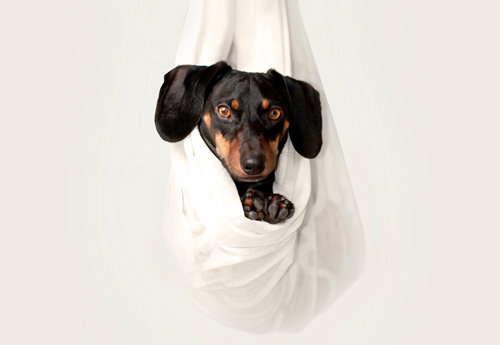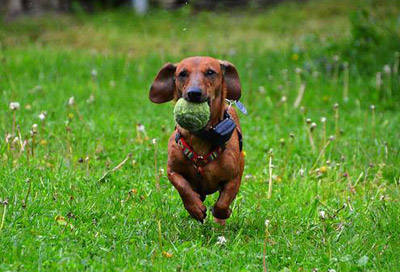
Dachshund
Group: Hound Group
Origin: Germany
Height:
- Miniature: Approx. 8 inches (20cm) tall at the shoulders; 20 inches (50cm) long, nose to rump; and 6 inches (15cm) wide.
- Standard: 30-40% larger than the Miniature.
- Wirehaired: Slightly higher off the ground than the Smooth and Longhaired.
Weight:
- Miniature: The ideal weight is 10lb (4.5kg)
- Standard: Over 11lbs (5kg)
CLICK HERE to View Breeder Listings
Note: In Canada, the U.S. and the United Kingdom, two sizes of Dachshunds are recognized — Standard and Miniature; and three coat types — the Smooth, Longhaired and Wirehaired. Taking the two sizes and three coat varieties into account, the Canadian Kennel Club and The Kennel Club (U.K.) recognize six distinct Dachshund types. The Fédération Cynologique Internationale recognizes the three coat types and three sizes — Teckel, Miniature Teckel, and Rabbit Teckel which is smaller than the Miniature.
Breed Profile
Dachshunds, also known as Dackels or Teckels, were developed in Germany and used to hunt badger and fox since the Middle Ages. The original Dachshund was the Standard Smooth. The name “dachshund” means “badger dog” in German. Dachshunds work in packs and are strong and fearless when sent underground to rout out the badger. These short-legged dogs were well recognised and known as one of the most versatile and useful breeds for hunting both below and above ground. The oldest breed Club is the Deutsche Teckelklub e.V. which was founded in 1888.
The Standard Wire Haired Dachshund is based on the Standard Smooth but also has some Terrier added in. The cross was done to improve the protective and weather-resistant qualities of the coat and to add a bit of Terrier temperament.
Developed from the original Standard Smooth Dachshund, the Long-haired was created by crossing the breed with the Field Spaniel. This variety has all the attributes of the Smooth but the outline is enhanced by soft feathering on the throat, ears, underbody and tail, giving it an unmistakable elegance.
The Miniature Dachshunds were bred to hunt the rabbits that destroyed farmers’ crops. These little dogs must be small enough to slip down rabbit holes and, in their native Germany, they are classifed according to girth, not weight.
The Dachshund is clever, lively, fearless, persistent and outgoing. With his fun-filled outlook, he is an affectionate and wonderful family companion.
The Dachshund’s lively and active personality make him an ideal participant in several dog sports and activities, such as Obedience, Agility, Tracking, Earth Dog Trials, Field Work, and Hunting.
Health Issues
As with all breeds, the Dachshund can be prone to some health problems. The following are the most common found in the breed:
- Intervertebral Disk Disease
- Diabetes Mellitus
- Hip Dysplasia
- Epilepsy
- Eye Diseases
- Hypothyroidism
- Gastric Torsion (Bloat) — As with any deep-chested dog, the occurrence of Bloat or Gastric Torsion is a real possibility in the Dachshund. If you are not familiar with this condition, it is absolutely necessary to learn about it and know the symptoms — This is a real emergency and a life threatening condition that requires immediate Veterinary attention. See Gastric Dilatation Volvulus (GDV) — Bloat in the Health and Nutrition section of the Canada’s Guide to Dogs website for more information and First Aid for Bloat for an article describing some of the things you can do if you are faced with this situation.
If you are considering the adoption of a Dachshund puppy, or any breed, it is very important to be selective in choosing a responsible and reputable breeder. Ensure that the prospective puppy’s parents have all health clearances. Breeding of any dog should not be done until after they have been proven to be free of evidence of significant hereditary diseases. (For more information on selecting a breeder, see the articles on the General Information page.)
Recommended Health Screening:
For the Dachshund, the CHICNOTE 1 database includes health screenings for:
- Eye Examination by a board Ophthalmologist
- Patellar Luxation
- Also listed as “Optional:” Progressive Retinal Atrophy; Autoimmune Thyroiditis; Congenital Deafness
Additional Health Resources:
- Dachshund Club of America Health & Welfare Trust Fund
- Dodger’s List — Dachshund Orthopedic Disc Group Email Resource
Dachshund owners and potential owners should visit this site for valuable information on back problems and the latest information on treatments. - Dodgerslist – Support & Education for Disc Disease — The premier forum on care and protection for dogs suffering from intervertebral disc disease (IVDD).
- Canine Inherited Disorders Database — Dachshund
- Health and Nutrition — Growing section of the Canada’s Guide to Dogs website which includes information on several health and nutrition related issues.
- Canine Health Information Center (CHIC) – Recommended Health Screening for the Dachshund Breed — Providing a source of health information for owners, breeders, and scientists that will assist in breeding healthy dogs. CHIC is a centralized canine health database jointly sponsored by the AKC/Canine Health Foundation (AKC/CHF) and the Orthopedic Foundation for Animals (OFA).
- AKC Canine Health Foundation — Working towards developing scientific advances in canine health.
- OFA – Companion Animal Eye Registry (CAER)
- Orthopedic Foundation for Animals (OFA)
- Ontario Veterinary College (OVC)
- PennHIP
- HealthGene — HealthGene Corporation is the leading provider of veterinary DNA diagnostic services in Canada.
- Labgenvet — Laboratory of Veterinary Genetics is a Canadian diagnostic laboratory that offers a comprehensive service of DNA tests for veterinary genetic diseases.
Breed Standards
- CKC Breed Standard
- AKC Breed Standard
- UKC Breed Standard
- The Kennel Club (U.K.) Dachshund (Smooth Haired) Breed Standard
- The Kennel Club (U.K.) Dachshund (Miniature Smooth Haired) Breed Standard
- The Kennel Club (U.K.) Dachshund (Wire Haired) Breed Standard
- The Kennel Club (U.K.) Dachshund (Miniature Wire Haired Breed Standard
- The Kennel Club (U.K.) Dacshund (Long Haired) Breed Standard
- The Kennel Club (U.K.) Dachshund (Miniature Long Haired) Breed Standard
- FCI-Standard No. 148

Grooming Information
- Grooming — This section of the Canada’s Guide to Dogs website includes tips, articles and information covering all aspects of dog grooming along with a listing of Groomers from across Canada.
Training Resources
- Training — For training information, see this growing section of the Canada’s Guide to Dogs website for tips, articles, as well as listings of training centres across Canada.
Additional Information
- Dachshund Club of America Pedigree Database
- Clubs, Sports & Activities — For information on the many sports and activities you can get involved in with your dog.
- Working Dogs — The Working Dogs section of the Canada’s Guide to Dogs website provides information and listings of organizations that are involved in various dog jobs, such as Guide Dogs, Therapy Dogs, Police Dogs, Protection Dogs, and much more.
Famous Dachshunds
Dachshunds have been cherished by dog lovers for centuries. Here are some famous Dachshund dogs that have left their mark throughout history:
Waldi: The first official Olympic mascot, Waldi, was a Dachshund. Created for the 1972 Summer Olympics in Munich, Waldi represented the attributes of resistance, tenacity, and agility. This playful and colorful Dachshund became an iconic symbol of the Olympic Games.
Pablo Picasso’s Lump: The renowned artist Pablo Picasso had a Dachshund named Lump. This little dog was not only Picasso’s loyal companion but his love for Lump is evident in the sketches and paintings he created featuring the charming Dachshund.
Slinky, the Wiener Dog in Toy Story: In the beloved animated movie “Toy Story,” there is a memorable Dachshund character named Slinky Dog. Voiced by Jim Varney, Slinky is a loyal friend and part of Woody’s gang of toys. His elongated body and friendly demeanor make him a fan favorite.
Libby, the Therapy Dachshund: Libby gained recognition as a therapy dog working in various settings, including schools, hospitals, and nursing homes. She became an inspiration for her work in providing comfort and companionship to those in need.
These are just a few examples of Dachshunds that have achieved fame, whether through social media, art, movies, or real-life stories. Their unique appearance and charming personalities continue to captivate people around the world.
*NOTE 1: CHIC – The Canine Health Information Center “is a database of consolidated health screening results from multiple sources. Co-sponsored by the Orthopedic Foundation for Animals (OFA) and the American Kennel Club (AKC) Canine Health Foundation, CHIC works with parent clubs to identify health screening protocols appropriate for individual breeds. Dogs tested in accordance with the parent club established requirements, that have their results registered and made available in the public domain are issued CHIC numbers.” To learn more, visit: www.caninehealthinfo.org
*NOTE 2: The Fédération Cynologique International (FCI) is the World Canine Organization, which includes 91 members and contract partners (one member per country) that each issue their own pedigrees and train their own judges. The FCI recognizes 344 breeds, with each being the “property” of a specific country. The “owner” countries write the standards of these breeds in co-operation with the Standards and Scientific Commissions of the FCI, and the translation and updating are carried out by the FCI. The FCI is not a breed registry nor does it issue pedigrees.
Breed Listing
Quick Links
Get In Touch
- Email: canadasguidetodogs@gmail.com
- Email: info@canadasguidetodogs.com
- Visit us on Facebook: www.facebook.com/CanadasGuideToDogs
— CanadasGuideToDogs.com is an Amazon Associate as well as a participant in various affiliate programs, as such fees are earned from qualifying purchases.

